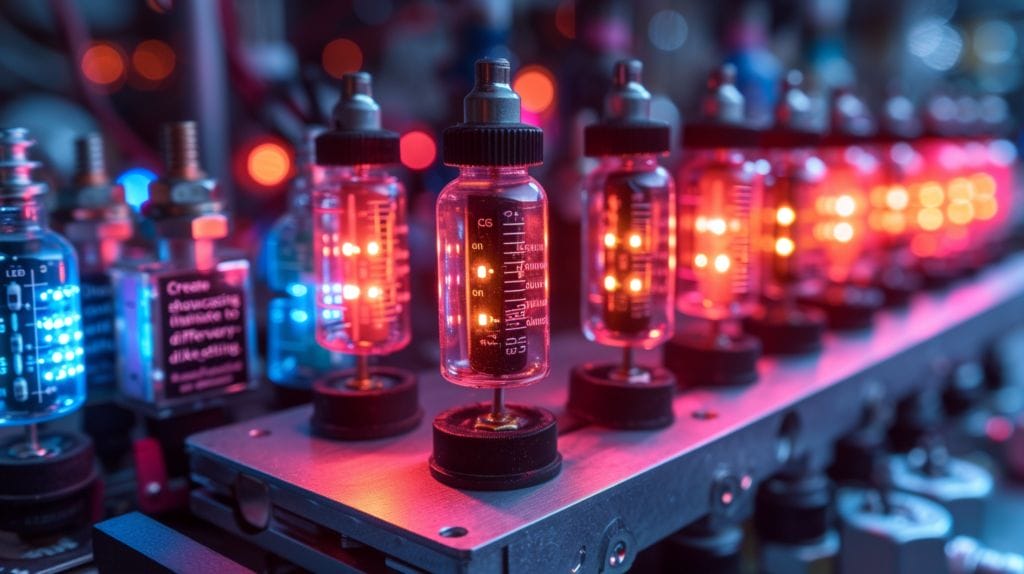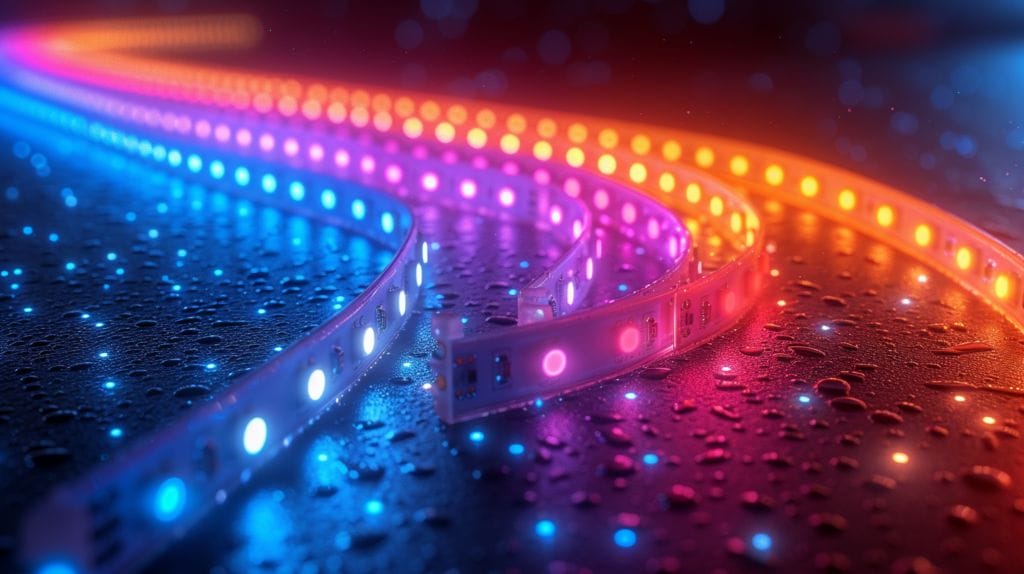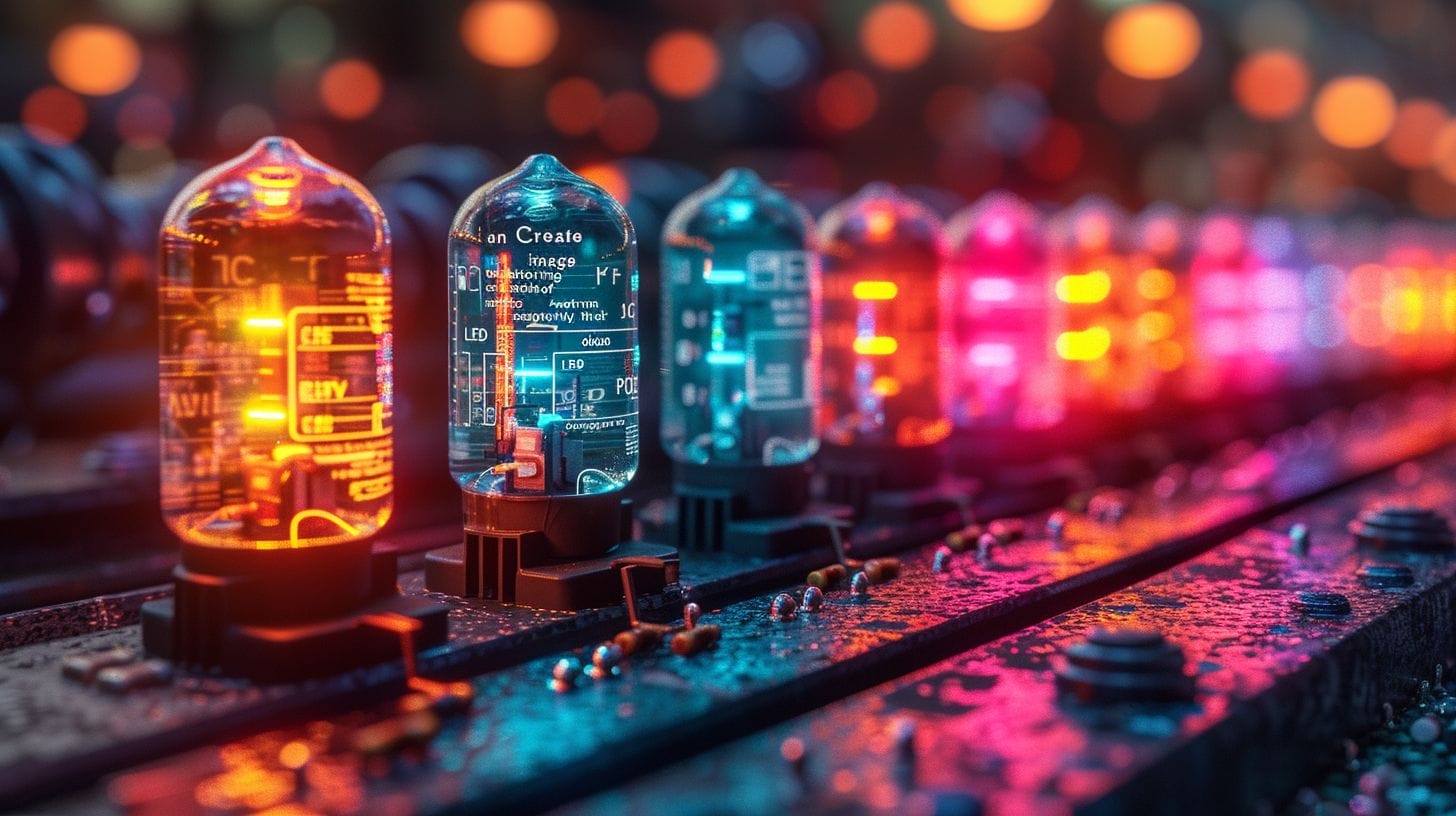LED Forward Voltage by Color: Guide on Diode Specifications
Step into a room bathed in the soothing hues of LED lights, each color illuminating the space with its unique voltage. Join us as we explore the intricate relationship between LED color and forward voltage.
LEDs, or Light Emitting Diodes, are more than just tiny sources of light in our lives. They’re fascinating devices that embody a complex interplay of physics and engineering. In our ‘LED Forward Voltage by Color’ guide, we’ll demystify the concept of forward voltage in LEDs, its impact on LED color, and why it’s pivotal for those working with these ubiquitous components.
Key Takeaways
- LED forward voltage is crucial for proper LED function and determines the necessary power supply.
- Different LED colors require different forward voltages, directly influencing their performance and resulting in varying energy levels.
- Using forward voltage in LED circuits and power supplies, such as in a high power LED, boosts efficiency and lifespan.
- Practical considerations, such as selecting an appropriate power supply and troubleshooting common issues, optimize LED performance and efficiency for LEDs, including the RGB LED.
Understanding LED Forward Voltage: An Introduction to LED Lighting

Let’s dive into the world of LED lighting, starting with the essential concept of forward voltage and understanding how LEDs are made. It plays a crucial role as it dictates the necessary power supply for the LED to function properly. It’s akin to a key that unlocks the LED’s potential, dictating how bright it can shine and what colors it can produce.
Different LEDs, like the red LED or blue LED, require different forward voltages, influencing not only their performance but also their color; therefore, the color depends on the type of semiconductor material used. Typically, red LEDs have a lower forward voltage, while blue and white LEDs require a higher forward voltage. This is due to the materials used in their construction and the energy levels required to produce different colors.
The Relationship Between Forward Voltage and LED Colors

Diving into the relationship between forward voltage and LED colors, it’s important to understand that the forward voltage directly determines the color of an LED. This striking fact forms the basis of our guide on diode specifications.
To fully appreciate this relationship, we must first consider that different LED colors require different energy levels to function, hence the varying forward voltages, and this is influenced by the type of diode and the semiconductor material used.
Let’s delve deeper by exploring the typical forward voltage ranges for common LED colors:
- Red LEDs: Mostly, they require around 1.8 to 2.2 volts, a relatively low voltage.
- Green LEDs: They usually need about 2.0 to 2.4 volts
This differential isn’t a manufacturing fluke, but a result of the intrinsic properties of the diode materials used.
However, it’s crucial to note that forward voltage isn’t an absolute constant. Several factors can influence it, such as:
- Temperature variations
- High temperatures on either side of the LED
- Manufacturing variances
- Different production batches may exhibit slight variations
Incorporating Forward Voltage into LED Circuits and Power Supplies

Understanding the role of resistors is the first step in incorporating forward voltage into LED circuits. Resistors play a crucial role in current limiting and voltage regulation for LEDs, working to limit the amount of current flowing. Using Ohm’s Law, we can calculate the required current limiting resistor, ensuring a stable power supply and optimal LED performance.
Next, we need to introduce LED drivers into our circuits. These power supplies control the forward voltage and current, providing consistent performance and protecting the LEDs from voltage fluctuations.
Incorporating forward voltage into LED circuits and power supplies is a testament to our desire for innovation and efficiency. With this knowledge, we’re not just building circuits; we’re crafting the future of LED technology.
To summarize, here’s a quick guide on incorporating forward voltage:
| Steps | Key Points |
|---|---|
| Understand the role of resistors | Current limiting, Voltage regulation |
| Calculate the required resistor | Use Ohm’s Law |
| Introduce LED drivers | Control forward voltage and current |
| Adjust LED drivers | Ensure consistent performance |
| Follow diode specifications | Enhance efficiency, longevity |
Incorporating forward voltage into LED circuits and power supplies is a testament to our desire for innovation and efficiency. With this knowledge, we’re not just building circuits; we’re crafting the future of LED technology. Let’s continue breaking barriers and lighting up our world!
Practical Considerations for Working with LED Forward Voltage

When working with LED forward voltage, it’s essential to consider practical aspects. These include selecting an appropriate power supply, understanding the impact of forward voltage on LED brightness and efficiency, and mastering common troubleshooting techniques.
In selecting an appropriate power supply for LED applications, we should bear in mind that the power supply must match the forward voltage of the LED. A mismatch could lead to a reduced lifespan or even damage to the LED.
Understanding the influence of the forward voltage drop across the LED on its brightness and efficiency is as essential as comprehending the current passing across the resistor. A higher forward voltage means a brighter output, but it also means greater power consumption.
Does Understanding LED Light Anode and Cathode Help in Determining Forward Voltage by Color?
Understanding led light core understanding the anode and cathode can indeed help in determining the forward voltage by color. The anode is typically the longer leg, and the cathode is the shorter leg. Different colors of LEDs have different forward voltage requirements, so this knowledge is crucial for proper usage.
Advanced Concepts and Future Developments in LED Forward Voltage

Let’s investigate the more advanced ideas and future trends in LED forward voltage and learn about LED technology’s complexities. The forward voltage drop is crucial in determining the energy efficiency of an LED. Lower forward voltage results in less power required to light the LED, hence improving its efficiency.
Advanced concepts in diode specifications focus on techniques for precise control of forward voltage across an LED. One technique is the use of steady current sources that supply a regular current to the LED, leading to a stable forward voltage – a critical factor for a high power LED.
In terms of future developments, we’re seeing emerging trends and technologies focusing on optimizing LED performance by leveraging forward voltage. Innovations in LED technology are targeting not just the efficiency, but also the color output of individual LEDs, including those of a three LEDs system, RGB LED. For instance, dynamic forward voltage adjustment based on color output requirements is an area with significant potential.
Conclusion
To conclude, we’ve thoroughly examined the significance of forward voltage in an LED with a forward voltage, especially in a high power LED. We’ve discussed its relationship with LED colors and how to incorporate it into circuits and power supplies.
We’ve also touched on practical considerations and future developments. Understanding these complex concepts can really light up your LED projects.
So, let’s continue to illuminate our knowledge on LEDs. And remember, the future of lighting is looking bright.
Frequently Asked Questions
What are LEDs?
LEDs, or light emitting diodes, are a type of semiconductor light source that can convert electrical energy into light. They are available in a wide range of colors and are popular in various electronic applications.
What is forward voltage in relation to LEDs?
Forward voltage in LEDs refers to the voltage drop across the LED when it is forward biased. The forward voltage across an LED is the voltage required to limit the forward current flowing through the LED and varies depending on the color and type of LED, for instance a red LED or a blue LED.
How does the forward voltage affect the brightness of an LED?
The forward voltage of an LED is directly related to its brightness. When you have one LED, a higher forward voltage generally indicates a brighter LED but it’s important to consider the voltage drop will of course affect the current flow and current limiting resistor in the circuit to control the brightness effectively.
What is the purpose of a current limiting resistor in an LED circuit?
A current limiting resistor is used in an LED circuit to control the amount of current flowing through the LED. It helps to protect the LED from excessive current flow and ensures that the LED operates within its specified parameters.
Can I connect an LED directly to a battery without a current limiting resistor?
You should not connect an LED directly to a battery without a current limiting resistor. Ignoring this precaution may subject the LED to much current, which can potentially damage it. It is important to use a current limiting resistor to protect the LED.







